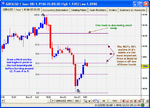TheWolf
Member
- Messages
- 72
- Likes
- 0
Does anyone use fibs? Can you offer me any tips on it? I know that prices often turn at around 50%, and that's about it.  How well does it work on 5 minutes chart? The 'rough to peak' wave, should it be the most recent wave used? Is it better to use fibs on bigger waves?
How well does it work on 5 minutes chart? The 'rough to peak' wave, should it be the most recent wave used? Is it better to use fibs on bigger waves?
Last edited:


